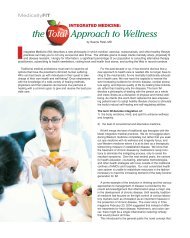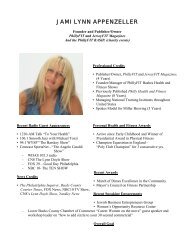⢠Running the Right Way - PhillyFIT Magazine
⢠Running the Right Way - PhillyFIT Magazine
⢠Running the Right Way - PhillyFIT Magazine
- No tags were found...
You also want an ePaper? Increase the reach of your titles
YUMPU automatically turns print PDFs into web optimized ePapers that Google loves.
S E N I O R G U I D EHEALTHIER AGING ADULTSBy John FairchildAging adults who routinely include healthy behaviors, are preventativewith <strong>the</strong>ir health care services, and have a supportivesocial network are more likely to remain healthy, be more independent,and incur fewer health costs. Essential components tokeeping aging adults healthy is preventing chronic diseases andreducing associated complications by eating right and beingactive.Eating right and staying active are important preventive healthmeasures during <strong>the</strong> lifespan. As we get older our bodies havedifferent needs. Certain nutrients become especially importantfor overall good health.CALCIUMAging adults need more calcium and vitamin D to help maintainbone health. Two to three servings of low-fat / fat-free milk oryogurt included with a plant based diet will ensure adequatelevels each day. O<strong>the</strong>r calcium-rich foods include fortified cereals,some fruit juices, dark greens such as kale and spinach andcanned fish.MAGNESIUMEvidence suggests that magnesium may play an important rolein regulating blood pressure. Diets that provide plenty of fruitsand vegetables, which are good sources of potassium and magnesium,are consistently associatedwith lower blood pressure. Foodsources include nuts, beansand vegetables.FIBEREat more fiber-rich foods to staymaintain a healthy digestive tract.Fiber also can help lower your riskfor heart disease, control yourweight and prevent type 2 diabetes.Consuming whole-grainbreads, cereals, and more beanswill help you acquire your dailyneeds. Fruits and vegetablesalso provide beneficial fiber.POTASSIUMIncreasing potassium alongwith reducing sodium maylower your risk of highblood pressure and stroke. Fruits, potatoes, beans, dark greens,vegetables and low-fat or fat-free milk and yogurt are goodsources of potassium. Also, select and prepare foods with littleor no added salt.KNOW YOUR FATSAvoid high fat foods, like marbled red meats, poultry skin, friedfoods and fast foods to help reduce your risk of heart disease.Foods that are low in saturated fats, trans fats and cholesterolmay also lower your health risks. Most of <strong>the</strong> fats you eatshould be polyunsaturated and monounsaturated fats such asolive oil, canola oil and nut butters.INCREASE YOUR INTAKE OF PROTECTIVE FOODS.Current research suggests that certain foods may reduce <strong>the</strong> riskof heart disease and stroke, and help maintain a healthy brain.Generally, dark-skinned fruits and vegetables have <strong>the</strong> highestlevels of antioxidants. Sources include: kale, spinach, red pepper,onion, brussel sprouts, alfalfa sprouts, broccoli, beets, andeggplant. Fruits with high antioxidant levels include: blueberries,blackberries, strawberries, raspberries, red grapes, plums,oranges, and cherries.Omega 3 fatty acids from cold water fish such as halibut, mackerel,salmon, trout and tuna provide many health benefits aswell as anti-inflammatory properties. Nuts also contain Omega3 fatty acids. Include some almonds, pecans and walnuts in yourdiet.ASK THE DOCTORIf you have a specificmedical condition,be sure to checkwith your primaryphysician or a registereddietitianabout foods youshould include oravoid.Submitted by John FairchildLiberty Lu<strong>the</strong>ranArtman215-283-9999jfairchild@libertylu<strong>the</strong>ran.org22 I <strong>PhillyFIT</strong> May/June I 267-767-4205 I www.phillyfit.com
















